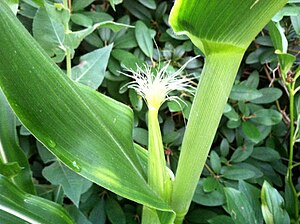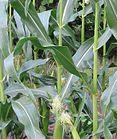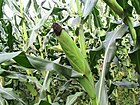Note: This is a project under development. The articles on this wiki are just being initiated and broadly incomplete. You can Help creating new pages.
Difference between revisions of "Zea mays"
(→References) |
|||
| (5 intermediate revisions by the same user not shown) | |||
| Line 1: | Line 1: | ||
[[File:Corn (7485955792).jpg|thumb|right]] | [[File:Corn (7485955792).jpg|thumb|right]] | ||
| − | '''Zea mays''' is an erect, robust, usually unbranched annual plant. It can grow up to 6 metres tall but is more likely to around 2 metres with cultivars that can range from around 1 metre up to 3 metres or more. Maize is one of the most commonly cultivated crops in the world, providing a range of foods including popcorn, sweetcorn and a grain that can be ground into a flour | + | '''Zea mays''' is an erect, robust, usually unbranched annual plant. It can grow up to 6 metres tall but is more likely to around 2 metres with cultivars that can range from around 1 metre up to 3 metres or more. Maize is one of the most commonly cultivated crops in the world, providing a range of foods including popcorn, sweetcorn and a grain that can be ground into a flour. |
==Uses== | ==Uses== | ||
| − | {{Uses|}}, {{Uses|}}, {{Uses|}}, {{Uses|}}, {{Uses|}}, {{Uses|}}, {{Uses|}}, {{Uses|}}, {{Uses|}}, {{Uses|}}, {{Uses|}}.<ref name="Uses"/> | + | {{Uses|Strangury}}, {{Uses|Dysuria}}, {{Uses|Diabetes}}, {{Uses|Gonorrhoea}}, {{Uses|Gout}}, {{Uses|Cystitis}}, {{Uses|Nose bleeds}}, {{Uses|Menorrhagia}}, {{Uses|Ulcers}}, {{Uses|Swellings}}, {{Uses|Rheumatic pains}}.<ref name="Uses"/> |
==Parts Used== | ==Parts Used== | ||
| − | {{Parts Used|}} | + | {{Parts Used|A grain of corn}}<ref name="Karnataka Medicinal Plants"/> |
| + | |||
==Chemical Composition== | ==Chemical Composition== | ||
| − | <ref name="chemical composition"/> | + | Chemical constituents of corn grains are total P mg/g, total N mg/g, |
| + | crude protein %, carbohydrate %, T.S.S. %, starch % and oil etc.<ref name="chemical composition"/> | ||
==Common names== | ==Common names== | ||
| − | {{Common names|sa=|en=|gu=|hi=|kn=|ks=|ml=|mr=|pa=|ta=|te=}} | + | {{Common names|sa=Yavanala|en=Mej|gu=|hi=Maakai|kn=Govina Jola, Mekke Jola|ks=|ml=Jolam|mr=|pa=|ta=Makka Jolam|te=Mokka Jonna}}<ref name="Karnataka Medicinal Plants"/> |
==Properties== | ==Properties== | ||
| Line 36: | Line 38: | ||
===Flower=== | ===Flower=== | ||
| − | {{Flower||||}} | + | {{Flower|||||Flowering season is August - November}} |
===Fruit=== | ===Fruit=== | ||
| − | {{Fruit||||||}} | + | {{Fruit||||||Fruiting season is August - November}} |
===Other features=== | ===Other features=== | ||
| Line 48: | Line 50: | ||
==Mode of Propagation== | ==Mode of Propagation== | ||
| − | {{Propagation|}} | + | {{Propagation|Seeds}} |
==How to plant/cultivate== | ==How to plant/cultivate== | ||
| Line 69: | Line 71: | ||
==References== | ==References== | ||
<references> | <references> | ||
| + | <ref name="chemical composition">[http://citeseerx.ist.psu.edu/viewdoc/download?doi=10.1.1.1066.2594&rep=rep1&type=pdf Chemical constituents]</ref> | ||
| + | <ref name="Leaf">[Morphology]</ref> | ||
| + | <ref name="How to plant/cultivate">[http://tropical.theferns.info/viewtropical.php?id=Zea+mays Cultivation]</ref> | ||
| + | <ref name="Uses">Indian Medicinal Plants by C.P.Khare</ref> | ||
| − | <ref name=" | + | <ref name="Karnataka Medicinal Plants">"Karnataka Medicinal Plants Volume - 2" by Dr.M. R. Gurudeva, Page No.571, Published by Divyachandra Prakashana, #45, Paapannana Tota, 1st Main road, Basaveshwara Nagara, Bengaluru. </ref> |
| − | |||
| − | |||
| − | |||
| − | |||
</references> | </references> | ||
==External Links== | ==External Links== | ||
| − | * [ ] | + | * [https://pfaf.org/user/plant.aspx?LatinName=Zea+mays Zea mays on pfaf.org] |
| − | * [ ] | + | * [https://www.sciencedirect.com/topics/agricultural-and-biological-sciences/zea-mays Zea mays on sciencedirect.com] |
| − | + | ||
| + | |||
[[Category:Herbs]] | [[Category:Herbs]] | ||
Latest revision as of 17:21, 22 June 2023
Zea mays is an erect, robust, usually unbranched annual plant. It can grow up to 6 metres tall but is more likely to around 2 metres with cultivars that can range from around 1 metre up to 3 metres or more. Maize is one of the most commonly cultivated crops in the world, providing a range of foods including popcorn, sweetcorn and a grain that can be ground into a flour.
Contents
- 1 Uses
- 2 Parts Used
- 3 Chemical Composition
- 4 Common names
- 5 Properties
- 6 Habit
- 7 Identification
- 8 List of Ayurvedic medicine in which the herb is used
- 9 Where to get the saplings
- 10 Mode of Propagation
- 11 How to plant/cultivate
- 12 Commonly seen growing in areas
- 13 Photo Gallery
- 14 References
- 15 External Links
Uses
Strangury, Dysuria, Diabetes, Gonorrhoea, Gout, Cystitis, Nose bleeds, Menorrhagia, Ulcers, Swellings, Rheumatic pains.[1]
Parts Used
Chemical Composition
Chemical constituents of corn grains are total P mg/g, total N mg/g, crude protein %, carbohydrate %, T.S.S. %, starch % and oil etc.[3]
Common names
| Language | Common name |
|---|---|
| Kannada | Govina Jola, Mekke Jola |
| Hindi | Maakai |
| Malayalam | Jolam |
| Tamil | Makka Jolam |
| Telugu | Mokka Jonna |
| Marathi | |
| Gujarathi | |
| Punjabi | |
| Kashmiri | |
| Sanskrit | Yavanala |
| English | Mej |
Properties
Reference: Dravya - Substance, Rasa - Taste, Guna - Qualities, Veerya - Potency, Vipaka - Post-digesion effect, Karma - Pharmacological activity, Prabhava - Therepeutics.
Dravya
Rasa
Guna
Veerya
Vipaka
Karma
Prabhava
Habit
Identification
Leaf
| Kind | Shape | Feature |
|---|---|---|
Flower
| Type | Size | Color and composition | Stamen | More information |
|---|---|---|---|---|
| Flowering season is August - November |
Fruit
| Type | Size | Mass | Appearance | Seeds | More information |
|---|---|---|---|---|---|
| Fruiting season is August - November |
Other features
List of Ayurvedic medicine in which the herb is used
Where to get the saplings
Mode of Propagation
How to plant/cultivate
Plants grow well in lowland tropical areas and can succeed at elevations up to 2,000 metres.[5]
Commonly seen growing in areas
[[:Category:Herbs that are commonly seen in the region of |]], [[:Category:Herbs that are commonly seen in the region of |]], [[:Category:Herbs that are commonly seen in the region of |]], [[:Category:Herbs that are commonly seen in the region of |]], [[:Category:Herbs that are commonly seen in the region of |]].
Photo Gallery
References
- ↑ Indian Medicinal Plants by C.P.Khare
- ↑ 2.0 2.1 "Karnataka Medicinal Plants Volume - 2" by Dr.M. R. Gurudeva, Page No.571, Published by Divyachandra Prakashana, #45, Paapannana Tota, 1st Main road, Basaveshwara Nagara, Bengaluru.
- ↑ Chemical constituents
- ↑ [Morphology]
- ↑ Cultivation
External Links
- Ayurvedic Herbs known to be helpful to treat Strangury
- Ayurvedic Herbs known to be helpful to treat Dysuria
- Ayurvedic Herbs known to be helpful to treat Diabetes
- Ayurvedic Herbs known to be helpful to treat Gonorrhoea
- Ayurvedic Herbs known to be helpful to treat Gout
- Ayurvedic Herbs known to be helpful to treat Cystitis
- Ayurvedic Herbs known to be helpful to treat Nose bleeds
- Ayurvedic Herbs known to be helpful to treat Menorrhagia
- Ayurvedic Herbs known to be helpful to treat Ulcers
- Ayurvedic Herbs known to be helpful to treat Swellings
- Ayurvedic Herbs known to be helpful to treat Rheumatic pains
- Herbs with A grain of corn used in medicine
- Herbs with common name in Kannada
- Herbs with common name in Hindi
- Herbs with common name in Malayalam
- Herbs with common name in Tamil
- Herbs with common name in Telugu
- Herbs with common name in Sanskrit
- Herbs with common name in English
- Habit - Annual
- Index of Plants which can be propagated by Seeds
- Herbs that are commonly seen in the region of
- Herbs







